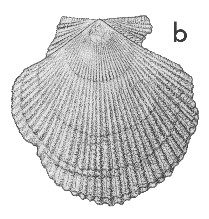
Revised descriptions of New Zealand Cenozoic Mollusca from Beu and Maxwell (1990)

 | Revised descriptions of New Zealand Cenozoic Mollusca from Beu and Maxwell (1990) | 
|
  (Pl. 4b): topotype, GS12140, CH/f254A, Tioriori, Chatham Island, late Waipawan(?) (GNS) |
Beu & Maxwell (1990): Chapter 6; p. 90; pl. 4 b.
Synonymy: Serripecten tiorioriensis Marwick 1928, p. 458
Classification: Pectinidae
Description: Small for genus (height 30-40 mm), known definitely only by the right valve, but left valve possibly represented by specimen from Pitt Island that is less inflated than right valve. Dorsal margins of right valve weakly divergent, finely serrate, those of putative left valve colinear. Radial sculpture on right valve of 37-38 narrow, rather low costae with somewhat broader interspaces, almost smooth over most of their length but becoming weakly scaly and developing a narrow, scaly costella in interspaces distally. Anterior ear with 4 or 5, posterior ear with 6 narrow, scaly radial costae. Presumed left valve with about 38 costae, more subdued than on right valve and becoming obsolete towards dorsal margins. Commarginal sculpture of growth lines and ridges.
Comparison: Serripecten tiorioriensis is the oldest known member of the genus (if, indeed, it is correctly referred there) and is differentiated from younger species by its small size and its relatively simple radial sculpture, particularly the nearly smooth nature of the costae and the late appearance of secondary costellae. Serripecten (which is also present in the Cenozoic of southern Australia) ranges up to Tongaporutuan in New Zealand and is one of the most characteristic pecten genera in shallow-water sediments, particularly in greensand and limestone. Only five species have been described to date, but several additional species are known, mostly from the Late Eocene and Early Oligocene (see below). Waller (2006, p. 15) proposed Tribe Serripectinini for Serripecten Marwick, 1928, Batequeus Squires & Demetrion, 1990 (Lutetian (Middle Eocene), Baja California, Mexico), Janupecten Marwick, 1928, and "Chlamys" chactavensis (Aldrich, 1895) from the Ypresian (Early Eocene) of southern USA (although Janupecten is here regarded as a synonym of Lentipecten (sensu stricto), indicating a different relationship for the true Lentipecten from its usual placement in New Zealand). Waller (2006, p. 16) regarded S. tiorioriensis as correctly placed as the earliest species of Serripecten, although he pointed out that some other early species assigned to the genus that have similar sculpture on the 2 valves do not belong in this tribe.
Distribution: Waipawan(?); Tutuiri Greensand, Tioriori, Chatham Island (type); Matanginui Limestone, mouth of Waipapa Stream, Chatham Island; ?Tarawhenua Peninsula, Pitt Island (uncommon at all localities).
Cite this publication as: "A.G. Beu and J.I. Raine (2009). Revised
descriptions of New Zealand Cenozoic Mollusca from Beu and Maxwell (1990). GNS
Science miscellaneous series no. 27."
© GNS Science, 2009
ISBN
978-0-478-19705-1
ISSN 1177-2441
(Included with a PDF facsimile file
copy of New Zealand Geological Survey Paleontological Bulletin 58 in CD version
from: Publications Officer, GNS Science, P.O. Box 30368 Lower Hutt, New
Zealand)